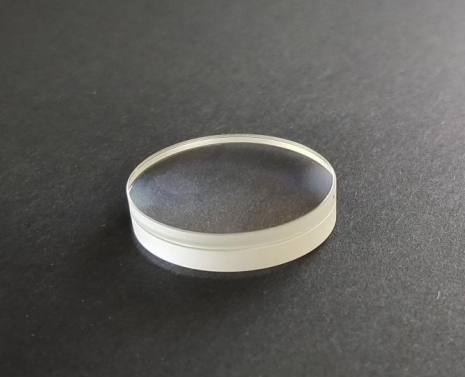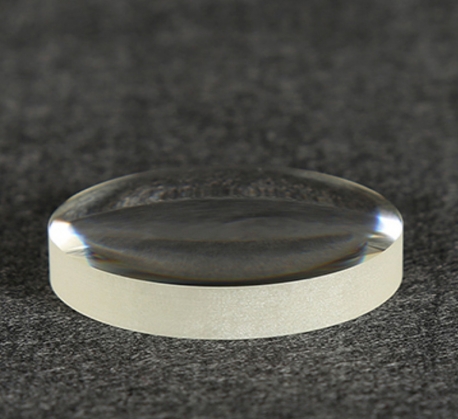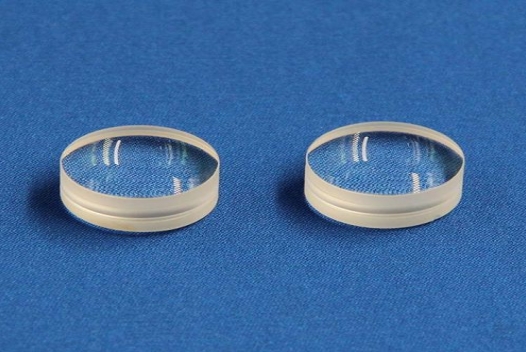Glued lens is an optical element composed of two or more lenses of different materials glued together by optical glue. The principle is based on the refraction law of light, that is, n1 sinθ1 =n2 sinθ2, where n1 and n2 are the refractive indices of the two media, and θ1 and θ2 are the angles of incidence and refraction of the light at the interface of the two media.
Lenses of different materials have different refractive indices. For example, crown glass has a relatively low refractive index and flint glass has a relatively high refractive index. When light enters from one material to another, it changes its direction according to the law of refraction.
For a single lens, chromatic aberration occurs due to the different refractive indices of light of different colors (wavelengths) in the lens. For example, in a converging single lens, blue light is refracted more strongly than red light and will focus closer to the lens.
By reasonably selecting two lenses of different materials glued together, the chromatic aberration can be corrected to a certain extent. If a crown glass lens is glued to a flint glass lens, the chromatic aberration caused by the difference in refractive index of Crown glass to blue and red light can be partially offset by the different refractive properties of flint glass to blue and red light. By accurately calculating the curvature radius, thickness and material of the two lenses, the focus of the two colors of light can be made to coincide or nearly coincide after the glued lens, thereby reducing the color difference.
For example, in the design of the telescope's objective lens, the glued lens can effectively reduce chromatic aberration, making the observed image clearer, and different colors of light can be better focused on the same plane. Compared with a single lens, glued lenses can greatly improve the quality of imaging, especially for optical instruments that require accurate imaging.
In addition to chromatic aberrations, glued lenses can also correct other aberrations, such as spherical aberrations. Through the reasonable design of each parameter of the glued lens, the light can be more close to the ideal imaging state after passing through the lens. For example, in photographic lenses, the use of glued lenses helps to reduce spherical aberration, make the image of the photo edge clearer, and reduce the distortion of the image.
The lenses glued together form a single structure, which is more stable than multiple lenses separated. When affected by external factors such as vibration, shock or temperature change, the glued lens is not easy to have relative displacement. For example, in optical equipment in the aerospace field, glued lenses can maintain the stability of optical systems under complex environmental conditions.
Since it is an integral component, the installation and adjustment of the glued lens in the optical system is relatively simple. In the assembly process of the optical instrument, it is only necessary to install the glued lens in the corresponding position according to the design requirements, and there is no need to carry out complex alignment and adjustment of multiple individual lenses.
In optical instruments such as astronomical telescope mirrors and bird-watching telescopes, glued lenses are widely used in objective lens parts. It can effectively reduce chromatic aberration and aberration, improve the image quality of the telescope, and enable the observer to see distant objects such as celestial bodies or birds more clearly.
Glued lenses are often used in camera lenses to correct erections. Whether it is a SLR camera lens or a phone camera, glued lenses help improve the sharpness and color reproduction of the image. For example, some high-end prime lenses will use multiple sets of glued lenses to achieve excellent optical performance.
Glued lenses are also used in microscope objectives and eyepieces. Under a high-power microscope, the glued lens can ensure the clarity and accuracy of the image, reduce the influence of color difference and aberration on the microstructure observation, so that researchers can more accurately observe the shape and structure of microscopic objects such as cells and microorganisms.
For example, in optical interferometers, spectrophotometers and other instruments, glued lenses are used to focus and collimate light to ensure the measurement accuracy of the instrument. Because these instruments require very high propagation and focusing of light, the achromatic and aberration correction capabilities of glued lenses are able to meet the needs of their accurate measurements.


